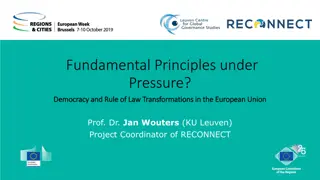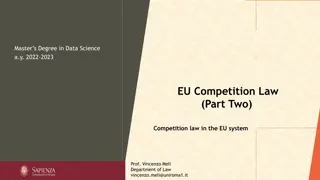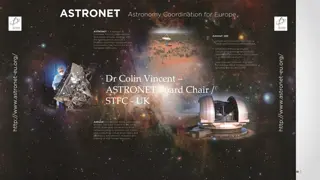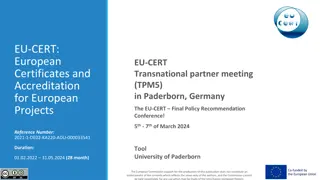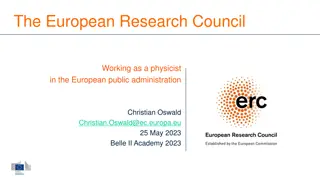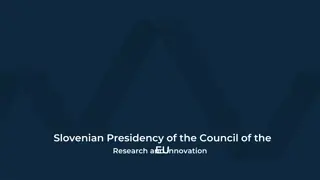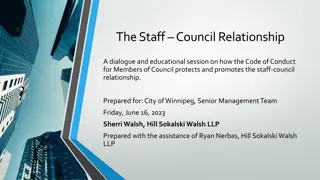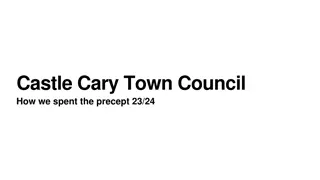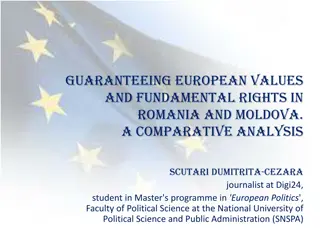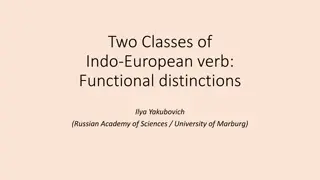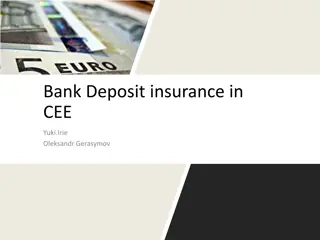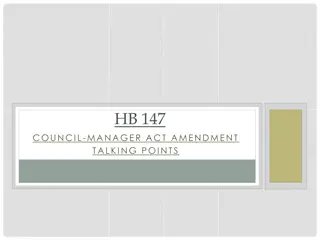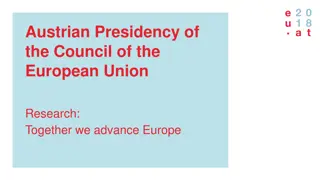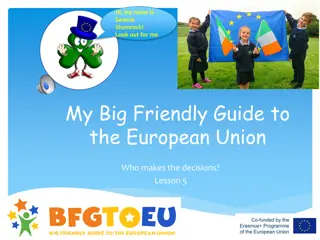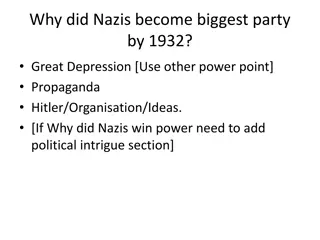
Evolution and Impact of the European Council in EU Governance
Explore the origins, development, leadership vacuum, and original aims of the European Council, highlighting its significant role in shaping EU decision-making processes and governance. Learn how this institution has evolved and gained power over the years.
Download Presentation

Please find below an Image/Link to download the presentation.
The content on the website is provided AS IS for your information and personal use only. It may not be sold, licensed, or shared on other websites without obtaining consent from the author. If you encounter any issues during the download, it is possible that the publisher has removed the file from their server.
You are allowed to download the files provided on this website for personal or commercial use, subject to the condition that they are used lawfully. All files are the property of their respective owners.
The content on the website is provided AS IS for your information and personal use only. It may not be sold, licensed, or shared on other websites without obtaining consent from the author.
E N D
Presentation Transcript
The European Council Dr Mina Chiba Waseda University 1
The European Council In this presentation, we offer a general overview of the role of the European Council in the EU s decision-making processes. We also trace the evolution of this institution, and its significant increase in power over the past decade. The presentation closely follows the discussion in Neill Nugent s The Government and Politics of the European Union, Palgrave, 2017, Eighth edition, chapter 11.
Origins and development of the European Council The European Council brings together the national leaders of the EU member states. It was originally only a marginal institution, but has arguably become the de facto head of governance of the EU system. No provision was made in the founding EU treaties for summit meetings of heads of government. A few such meetings did take place in the 1960s and 1970s, and at the Paris summit in 1974 it was decided to institutionalize these meetings of what became known as the European Council. There was a growing feeling among European elites that the EU system was failing to respond adequately or quickly enough to new and increasingly difficult challenges. 3
Leadership vacuum Neither the Commission nor the Council of Ministers were providing the necessary leadership for EU decision-making. The position of the Commission had been weakened by the intergovernmental emphasis on decision-making that was reconfirmed by the Luxembourg Compromise. The Council of Ministers was handicapped by its sectoralism, and the practice of only making decisions on the basis of unanimity. A new focus of authority was required, in order to make the EU system more effective, both domestically and internationally. French President Giscard d Estaing and West German Chancellor Schmidt were important in establishing the European Council. 4
Original aims of the European Council The European Council was originally established on a relatively informal basis so that heads of government could: Exchange ideas; Further mutual understanding at the highest political level; Give direction to policy development; Break deadlocks, and clear logjams. It was not anticipated that leaders would concern themselves with everyday matters, or policy detail. The formal creation of the European Council was very simple, and was reflected in a few paragraphs contained in the Paris summit communiqu . The communiqu did not precisely identify the role and functions of the European Council. It stated that the European Council would ensure progress, and that there would be consistency to the overall approach taken by the EU. 5
Treaty status of the European Council The European Council did not originally have treaty standing. The communiqu announced a political agreement between the national leaders, but it did not officially integrate the European Council into the EU framework. The European Council was therefore part of the unofficial approach to integration, rather than the official treaty-based approach. The Luxembourg Compromise and the development of foreign policy cooperation at this time are other examples of the unofficial approach. Over the years, however, there was a gradual constitutionalisation of the position and role of the European Council. This culminated in the Lisbon Treaty (2009) finally recognizing the European Council as a fully-fledged EU institution. 6
Historical lack of treaty base not a constraint The limited treaty basis of the European Council did not limit its ability to exercise influence and become an important decision-making institution. This is because the power and status of the national leaders who attend the meetings is very high. This means that there is little to stop them from deciding among themselves what the European Council will and will not do. As a result, the evolution and influence of the European Council reflects the preferences of the attendees, and to political and practical necessity, rather than to what is written in the treaties. Historically, in order to give itself as much freedom of operation as possible, the European Council has tried to avoid being based on, or subject to, tight and strict treaty rules and requirements. This is one of the reasons why the treaty references to the European Council (found in Article 15 of the TEU) are vague. It is deliberate, in order to maximize the room for manoeuvre of the European Council and the national leaders. 7
The European Council is important: a super council? This power to decide for itself means that the European Council exercises lots of different roles, and performs a number of different functions. These add up to an extremely important and impressive portfolio . The European Council is at the head and very heart of EU decision- making. The European Council is centrally involved in setting the overall parameters of the EU system. Legally binding decisions are not taken by the European Council, they are taken by other EU institutions. But major political decisions regarding the institutional and policy development of the EU are now taken by, or channeled through, the European Council. It is in this sense that European Council can be said to have provided the function of a super council that is missing in the Council of Ministers, as discussed in the first part of this topic presentation. 8
Membership of the European Council Before the Lisbon Treaty, there were two tiers of membership of the European Council. The top tier was made up of the Heads of Government and the President of the Commission. To provide this first tier with assistance, there was a second tier of Foreign Ministers of the member states, plus one other member of the Commission. The 2002 Seville summit made it possible for Foreign Ministers to be replaced in the room by other ministers for specific agenda items. This was a formal recognition of a process that had developed throughout the 1990s where other ministers, especially ECOFIN Ministers, made appearances at European Council meetings. 9
Post-Lisbon membership changes 1 The Lisbon Treaty provided for two important changes to membership. First, membership became more closely restricted to just one tier. This tier consists of Heads of Government, plus representatives of the EU. Other nation state ministers can still attend the summits, but only to assist, and only when the agenda so requires. Second, the Lisbon Treaty created the post of European Council President, and this person becomes a member of the European Council, along with the Heads of Government of the member states and the President of the Commission. The European Council only rarely takes decisions by having a formal vote. But when it does, neither the European Council President not the Commission President can vote (Article 235 TFEU). The Lisbon Treaty also created the position of High Representative of the Union for Foreign Affairs and Security Policy (HR). The HR can take part in the work of the EC, but is not a member of the European Council. 10
Post-Lisbon membership changes 2 As a result of post-Lisbon changes, therefore, the membership of the European Council for official summit sessions has been altered in the following ways: 1. There are more occasions when other sectoral ministers rather than Foreign Ministers accompany the Heads of Government; 2. There are more occasions when Heads of Government meet without ministerial accompaniment; 3. The European Council president is present; 4. The High Representative attends when external affairs agenda items are discussed. There has been an effort to keep the number of people in the summit meeting as small as possible, to allow for greater flexibility and formality. However, it is still the case that many people attend the meetings, for two reasons. Firstly, several countries have joined in the recent waves of enlargement. Second, decisions taken at European Council meetings have been becoming increasingly important. It can be seen from the photograph on page 184 of the Nugent textbook that the European Council setting does not encourage informality. Each member state has a suite close to the summit meeting room, and in practice several hundred people are in attendance at the summit, as official or unofficial members of state delegations. 11
The European Council President 1 Before the Lisbon Treaty, the EU member state who held the Presidency of the Council of Ministers also held the presidency of the European Council. The Presidency also therefore rotated between the member states every 6 months. An advantage of this approach was that every six months there was a chance for a new Head of Government to inject dynamism into EU processes at the highest level. Also, every member state had a chance to be in the spotlight. An important disadvantage was that regular turnover of leadership created disruption and a lack of consistency and coherence. A great burden was also placed on Heads of Government, and for some small member states the task of holding the European Council Presidency is arguably too demanding. 12
The European Council President 2 During the 2002-3 Constitutional Convention, it was decided that the disadvantages outweighed the advantages. The rotating Presidency would be replaced with the new post of a semi- permanent and appointed European Council President. There was some concern among EU staff and leaders of smaller and medium- sized states that this new post would lead to further confusion over the location of leadership in the EU, which would weaken the Commission and the Commission President. (Remember Kissinger s famous question; If I want to speak to Europe, who do I call? ). Some were worried that the creation of an European Council President would signal a shift towards greater control of EU affairs by member states. However these two concerns were also reasons why some member states did want to create the post. France and the UK were very keen to strengthen the position of the EC, and to see the EC have greater control over the political direction of the European Union. 13
Electing the European Council President The European Council President is elected to office by member states, by qualified majority voting. The post can be held for a maximum of five years, or two terms (one term is 2.5 years). The use of QMV is avoided wherever possible, because it undermines the authority of the President if it is known that he does not have the support of all member states. The use of QMV has been avoided in the appointment of all three of the Presidents of the European Council so far. There are two broad views as to what type of President should be appointed; the bolder view and the meeker view. 14
Bolder vs. meeker The bold view believes that the President should provide the EU with vigorous leadership, and allow the EU to project itself more effectively and dynamically on the world stage. What is required is a big-hitter with a high profile. In practice this means; a serving or a former Head of Government with a forceful personality from a large member state. The meek view believes that the president should be a competent politician with good chairing and mediating skills in national and perhaps also EU politics. In early November 2009 Herman von Rompuy, the serving Belgian Prime minister, was appointed as the first European Council President. 15
Herman von Rompuy: first European Council President 2009-2014 Herman von Rompuy reflected the meeker view of what the European Council President should be. Many of the EU s smaller member states strongly supported his appointment. They worried that a strong leader would work too much in the interests of larger member states. Also, France and Germany were concerned that they could be overshadowed on the European stage if the President was too charismatic. So they were also happy on this occasion to support the appointment of a lower profile consensus-builder. Van Rompuy did not actively involve himself in foreign policy and security matters. This was partly through personal preference, but partly because his time in office coincided with the economic crisis, which he was obliged to focus on. Source: FREDERICK FLORIN / AFP 16
Donald Tusk: second European Council President 2014-2019 There was a tilt towards the bolder approach in August 2014 with the appointment of Donald Tusk, the serving Polish Prime Minister, as von Rompuy s successor. Tusk was a former Foreign Minister as well as former Prime Minister. He was therefore personally more naturally inclined to take an interest in foreign policy than von Rompuy. One of the main issues that Tusk had to face during his time in office was the Ukraine Crisis, and difficult EU-Russia relations. These issues are also naturally important to a Polish national. Tusk was more assertive than van Rompuy, and went beyond brokering consensus and compromise, to offer leadership when necessary and when possible. Source: Kenzo TRIBOUILLARD / AFP 17
Charles Michel: third European Council President 2019- Charles Michel is the third holder of the post of European Council President. He was Prime Minister of Belgium for five years from 2014 until 2019, and was the youngest Belgian Prime Minister since 1845. Michel is a member of the Reformist Movement party (MR), which is an alliance between three French-speaking and one German-speaking liberal parties. Michel, as a male liberal from a medium-sized EU member state. He was selected as something of a counterpoint to the female, conservative van der Leyen, who is from Germany, the EU s largest and most powerful member state. Michel has a reputation as a consensus builder, having served as Prime Minister of politically divided Belgium. Source: Olivier HOSLET / EPA / AFP 18
Treaty provisions on the role of the European Council President The treaty powers of the European Council President are phrased in very general terms. Article 15(6) of the Lisbon Treaty states that: The President of the European Council: a. shall chair it and drive forward its work; b. shall ensure the preparation and continuity of the work of the European Council c. shall endeavour to facilitate cohesion and consensus within the European Council; d. shall present a report to the European Parliament after each of the meetings of the European Council. The President of the European Council shall, at his level and in that capacity, ensure the external representation of the Union on issues concerning its common foreign and security policy, without prejudice to the powers of the High Representative of the Union for Foreign Affairs and Security Policy (HR). Two obvious problems here are the vagueness of the job description, and the possibility of tension with regard to who does what, particularly in the realm of foreign policy, where the European Council President and the HR have potentially overlapping remits. 19
Organization of European Council summits From the Maastricht Treaty (2003) until the Lisbon Treaty (2009), the European Council was required to meet at least twice a year. These two meetings were held at the end of each six-month Council Presidency, in June and December. From the late 1990s onwards it became increasingly common for there to be three or four meetings per year. The 2002 Seville summit regularized this situation, by specifying that from then on the European Council would in principle meet four times a year; twice during each Council Presidency. The Lisbon Treaty reinforced this as a treaty requirement. Two of these summits are still held in June and December. The other stipulated two meetings are normally held in March and October. 20
Location of European Council summits Up until 2001 summits were held in the country which held the rotating Council Presidency. However, security became a more significant issue post-9/11, and it was also becoming clearer that it was not efficient to have such a large travelling circus. Many smaller countries were due to join the EU in 2004, and this created the prospect of many summits being held in small states, for whom the cost and logistics would arguably be too much of a burden. In practice nearly all European Council summits have been held in Brussels since 2003. However, the Brussels move was technically completed in 2009 when the new European Council Rules of procedure stated that apart from under exceptional circumstances, The European Council shall meet in Brussels . 21
Length of European Council summits The standard model for summits has been that they are held over a two-day period, beginning in the afternoon of day one, and ending in the late afternoon of day two. There have been departures from this model in practice, depending on the length and nature of agendas, and the politics of meetings. The longest summit took place at Nice in December 2000, which went over into a fifth day! Under Donald Tusk an effort has been made to tighten and shorten summits. There is an expectation that the four Scheduled summits, in March, June, October and December will last for two days, and this is mostly the case. However, the timing and length of Special or Informal summits depends largely on the reasons they have been called. But they mostly just last for one day, and often just for a few hours. Several of the Special and Informal meetings called to discuss Brexit over the last few years have fallen into this pattern. An interesting exception in the last few years was the Special meeting called from June 30th-July 2nd 2019, to finalize nominations for the posts of European Council President, Commission President, High Representative for Foreign Affairs, and President of the European Central Bank. This summit meeting lasted for 3 days. 22
Dramatic increase in European Council meetings The Lisbon Treaty also empowered the European Council President to convene special summits when required. Both van Rompuy and Tusk have regularly used this power. In both 2018 and 2019, there were 14 meetings of the European Council! In 2018, there were the four Scheduled European Council meetings, and there were also four meetings of the Euro Summit. Four Special meetings were held, all without the UK. Two of these Special meetings were timed to coincide with meetings of the Euro Summit, but two were held separately. There were also two Informal meetings, both of which were held separately from other meetings. In practice, this meant that in 2018 the Heads of Government went to Brussels for European Council meetings on ten separate occasions, sometimes for two days, sometimes for one day. In 2019, there were the four Scheduled meetings, and there were also two meetings of the Euro Summit. Six Special meetings were held, five of which were without the UK. Four of these six Special meetings were timed to coincide with Scheduled meetings of the European Council, but two were held separately. There were also two Informal meetings, both of which were held separately from other meetings. In practice, this meant that in 2019 the Heads of Government went to Brussels for European Council meetings on eight separate occasions, once for three days, sometimes for two days, and sometimes for one day. 23
Preparing European Council summits 1 Most of the responsibility for preparing summits was given to the European Council President when the new post was created. But it was widely felt by national governments and others that all preparatory (and therefore agenda-setting) power should not be given exclusively to the European Council President. As a result, the new post-Lisbon Treaty rules of procedure stated that the following actors should also be involved in summit preparations: the Head of Government of the Council of Ministers Presidency state; the Commission President; and the General Affairs Council of the Council of Ministers. Four weeks before every ordinary meeting of the European Council, an annotated draft agenda should be submitted to the General Affairs Council by the European Council President, the Commission president, and the President of the Council of Ministers. Other configurations of the Council of Ministers can propose agenda items for a European Council meeting up to two weeks before the meeting takes place. 24
Preparing European Council summits 2 The European Council President, in close cooperation with the other two Presidents, then prepares draft guidelines for the European Council Conclusions, and as appropriate, draft conclusions and a draft decision of the European Council. A final meeting of the General Affairs Council takes place within the final five days before the European Council summit, and after this meeting, the European Council President draws up the provisional agenda for the meeting. In the period between this final meeting of the General Affairs Council and the summit meeting itself, no other Council of Ministers or preparatory body is allowed to discuss any issues which are on the provisional agenda of the European Council summit meeting agenda. The European Council adopts the agenda at the beginning of its meeting. As a general rule, issues entered on the agenda should have passed through the screening process described above. 25
The standard model for European Council meetings: day one The following describes the normal format of two-day summits that open after lunch: On the basis of the agenda agreed in advance, a plenary session is held on the afternoon of day one. During breaks there are informal discussions between summit participants, and also between participants and their own supporting delegations. Plenty of time is allowed for this process. In the evening, dinner provides another opportunity for informal discussions. What happens after dinner depends on how the meeting is going. If the deliberations are stuck, there could be a reconvened plenary meeting, or important bilateral meetings between key players. During the night, officials work on a draft of conclusions of the first day s business, and/or on a form of words that can serve as a basis for further negotiations on the second day. 26
The standard model for European Council meetings: day two On the second day, another plenary session is held in the morning, and sometimes also in the afternoon. The discussions usually pick up from the previous day s discussions, but using the draft of conclusions from the first day which was produced overnight. Participants are now trying to move towards agreeing the conclusions for the summit meeting. As a result breakout sessions might be called to allow individual delegations to discuss the implications of proposals, or to allow for further informal discussions between different delegations who are finding it difficult to agree. The summit meeting ends with the issuing of formal European Council Conclusions . There is a very strong norm that everything in the statement is agreed to by all summit participants. Press conferences are then held, by the senior EU officials, and by each Head of Government. Up to 4,000 journalists attend European Councils, which have become major media events, because of their political significance for the administration of the EU. These high level meetings now generate high political theatre. 27
Setting the European Council agenda 1 What sort of issues appear on the summit meeting agenda, and why? Some of the most important circumstances under which issues appear on the agendas of normal summit meetings are as follows. 1. Some issues are on the agenda very often simply because of their intrinsic importance. For example, time is usually allowed for discussion of the general economic situation in the EU. Time is also usually allowed to discuss the internal market, Economic and Monetary Union (EMU), and the promotion of employment. Enlargement used to feature regularly on meeting agendas, but not so much for the last five years. 2. The specific international context at a particular time. Sometimes issues force themselves onto the agenda. For example, the global financial and economic crisis of 2007-8, and the migration crisis from 2014. 3. Sometimes, the Commission might be promoting new initiatives, for which it is also seeking European Council approval. 4. There could be a desire or a need to make or to formalize an institutional change to the EU. This is not as important now as during the 2000s, when many summits were taken up with treaty reform issues. 28
Setting the European Council agenda 2 5. Decisions might be needed on issues that require, or are seen to require, resolution by, or the approval of, the EC. An example of this is the content of the multiannual financial framework (MFF), and the annual budgets, even though procedurally they do not require the formal approval of the European Council. 6. Business may be left over from, or have been referred from previous summits. This happened, for example, in June 2015 and December 2015, with regard to the UK s wish to renegotiate its membership terms before the Brexit referendum in 2016. 7. Reports might have to be considered, or at least noted by the European Council. 8. External relations usually require discussions, declarations and decisions. Recent examples would include the Eastern partnership, Russia/Ukraine, and Libya. 29
The conduct of business in the European Council: voting There are three points about the conduct of business in the European Council to emphasize: 1. Decisions are almost always taken by unanimity, or rather by consensus, as it is in practice rare to have a formal vote. There is recognition that because the decisions that the European Council is called upon to take are high-profile and have important consequences. This means that there is a risk of immense internal political problems and disharmony if majority voting was used. States try very hard to reach agreements and to be accommodating when any particular member state has major difficulties with an issue. This longstanding preference for consensus was given treaty status in the Lisbon Treaty, in Article 15(4) of the Treaties of the European Union (TEU). According to this clause, Except where the Treaties provide otherwise, decisions of the European Council shall be taken by consensus . 30
The conduct of business in the European Council: influence 2. It is not always necessarily clear which states have the most power on the European Council. The larger states, such as Germany, naturally have more political and economic weight. They can be tough negotiators, and threaten to use the veto that all member states have. But large member states do not always get their way. Factors other than size can determine influence, and the extent of the influence that states exercise often varies between policy areas. For example, Germany is a hegemon with regard to Eurozone related issues, but not in respect of foreign policy. Cyprus is a very small state and normally exercises modest influence. But it is a key player with regard to Turkey, and has recently regularly vetoed the opening of new negotiating chapters. Similarly, Ireland has played a leading role with the Brexit process, with the EU showing a high level of economic and political support for Ireland in the way that it has conducted negotiations. There are non size-related factors that also determine influence: The importance of a policy area to a state s core interests (The more important an issue is for a member state, the more other states can accommodate a distinctive national position); The standing and competence of the Head of Government; and The determination of a member state to maximize its political influence. 31
The conduct of business in the European Council: Conclusions 3. The European Council Conclusions, which summarize summit outcomes, including the decisions taken, are mostly prepared before the national leaders meet. The drafting of these documents involves a time-consuming process, involving participation by the whole Brussels and national machineries. Most of the statements in the Conclusions are not the result of intense debate among the leaders themselves. Quite often the leaders who gather at a summit meeting merely agree to a draft prepared by national ministers and/or high ranking civil service figures. Usually only the most contested of matters are extensively discussed. There is similarity here with the A and B point system used in the Council of Ministers, with many of the agenda items having already been discussed and agreed, in advance. This leaves Heads of Government more time to address the truly important issues. You can find a comprehensive database of European Council Conclusions here: https://www.consilium.Europe.eu/en/European-council/conclusions/ 32
Activities of the European Council The EU is relatively free to decide what it may and may not do. Therefore, the activities of the European Council have tended to vary, according to preferences of member state participants, and the most important issues at the time. The European Council has increasingly taken on the role of a kind of board of directors . It sets the overall framework, and it discusses and takes broad decisions on major and contested issues. However, it leaves policy delivery to management , which in this case means: the European Council President, the Commission, the Council of Ministers, and the European External Action Service (EEAS). The main topics that the European Council concerns itself with are: 1. The evolution of the EU; 2. Constitutional and institutional matters; 3. The economic and monetary policies of the EU; 4. Enlargements; 5. External relations; 6. Specific internal policy issues 33
European Council Activities: evolution of the EU Several areas of European Council business relate to reviewing and guiding the general evolution of the EU. This includes: Setting out guidelines for general policy development, and also sometimes for development in specific policy areas. Monitoring progress in the creation of the single market. Troubleshooting when progress in building the EU is threatened. For example, trying to persuade the Irish people to approve the Lisbon Treaty, dealing with Brexit. Setting out framework principles when this is necessary, as with periodic statements since the 1990s emphasizing the importance of subsidiarity. Framing the parameters of EU income and expenditure, by determining the size and shape of the EU s MFFs, sometimes as early as two years before they are officially approved through the treaty processes. 34
European Council Activities: constitutional and institutional matters These matters come up in the European Council in three main forms. 1. The European Council takes important decisions relating to treaty development and reform. Since the mid-1980s, it has been a key player in the establishment and remits of IGCs (inter-governmental conferences) finalizing the content of treaties, and deciding what to do if treaties run into ratification difficulties. For example: The June 1985 Milan summit established the IGC that paved the way for the Single European Act, which was agreed at the December 1985 Luxembourg summit. The IGCs that worked on what became the Maastricht Treaty were established over a series of four summits in 1989 and 1990 (two Scheduled and two Special). The final negotiations on the Treaty were conducted at the December 1991 Maastricht summit. After the failure to ratify the Constitutional Treaty, the June 2005 summit decided on a period of reflection . The June 2006 summit asked the forthcoming German presidency to prepare a report to enable progress to be made. The October 2007 summit agreed on the contents of the Lisbon Treaty. The June 2009 summit agreed on a list of measures designed to persuade the Irish people to ratify the Treaty. A more recent example is the October 2019 summit, where the European Council endorsed the Agreement on the withdrawal of the United Kingdom of Great Britain and Northern Ireland from the European Union. 35
European Council Activities: constitutional and institutional matters 2. A range of specific institutional matters are considered and decided at summits, such as the number of seats to be given to states that will soon join the EU, and the location of newly created EU offices and agencies. Recently, the European Council decided how to reevaluate the allocation of seats in the European Parliament, as a result of the UK leaving. 3. The European Council takes important personnel decisions. It appoints its own President, the High Representative for Foreign Affairs, and senior members of the European Central Bank, including the President. The European Council proposes to the Parliament the person that it wishes to see appointed as Commission President, and it formally appoints the College of Commissioners once they have been given a parliamentary vote of consent. Because these appointments are so important, the process of selection can often be extremely politicized, difficult and protracted. Decisions can be taken by QMV if necessary, but this is avoided if at all possible. 36
European Council Activities: economic and monetary policies of the EU European Council summit meetings have always reviewed the overall economic and social situation within the EU. They have looked generally at economic growth, trade patterns, inflation, exchange rates, and unemployment. In recent years these economic deliberations, although they still fall far sort of producing a common economic policy for all member states, have acquired more bite. The main reason for this has been the post-2008 global financial and economic crises, followed from 2010 by the Eurozone and Greek crises. These crises obliged the EU s national leaders, along with EU policy-makers at all levels, to examine which EU responses are appropriate. Since 2008 the European Council, and where appropriate also Euro summits, have considered and authorized numerous actions relating to the crises. Matters covered have included tighter macroeconomic coordination, banking reform, the promotion of investment, rescue mechanisms for Eurozone states in financial difficulties (most obviously Greece), and the rules of the Eurozone. The European Council emerged as the centre of gravity in responding to these crises. As van Rompuy notes, the basic rules of monetary union were re-written over a series of European Council crisis summits. 37
European Council Activities: enlargement Most important decisions on EU enlargement are taken at European Council meetings, and usually, but not always, on the basis of recommendations from the Commission. In the years leading up to the 2004 and 2007 enlargements, the issue featured prominently at most summits. Activities included: considering membership applications; authorising the opening of accession negotiations; hearing reports from the Commission on the progress of negotiations; deciding whether negotiations had been successfully concluded; setting accession dates; or dealing with problems arising during the accession process. 38
European Council Activities: key enlargement decisions The many key decisions taken in the process that lead to the 2004 enlargement include: the agreement at the June 1993 Copenhagen summit that Central and Eastern European countries (CEECs) could in principle join the EU; the setting-out of an accession strategy at the December 1994 Essen summit; the confirmation at the 1997 Luxembourg summit of the Commission s recommendation that negotiations should open with five of the CEECs and Cyprus; the confirmation at the Helsinki 1999 summit that negotiations should be extended to the remaining five CEECs and Malta; the landmark agreement at the December 2002 summit that ten states had completed the accession negotiations successfully, and could join the EU in May 2004. 39
European Council Activities: declining recent emphasis on enlargement Since the big bang enlargement of 2004 and 2007 the enlargement process has become much less intense. Croatia s accession in 2013 was relatively straightforward, and the June 2013 summit decided to open negotiations with Serbia. However, in 2014 the incoming Juncker Commission made it clear that enlargement was not a priority, and that there would be no accessions in the foreseeable future. As a result, enlargement has featured less on summit agendas. There have been reports by the Commission on the progress of applicant states, and there are occasionally discussions which attempt to breathe new life into the stalled Turkish accession process. This may change in the future, as the von der Leyen Commission has signaled a commitment to a more geopolitical approach, and to reforming and re-energizing the enlargement process 40
European Council Activities: external relations The European Council is involved in the EU s external relations in three ways. 1. Since the Maastricht Treaty (1993), the European Council has had a strategic guidance role on the overall principles and direction of the EU s foreign and security policy. The relevant excerpt from the TEU is on the next slide. 2. Many seemingly non-foreign policy issues are not purely internal EU matters. Policy areas such as external trade, development, climate change and energy have a significant external dimension to them. European Council summits therefore often have such topics on their agendas, and consider them in the context of relations with the US, China, Russia and Japan, or international organizations such as the UN, G8, G20 and WTO. Foreign and security policy overlaps with and is connected with these other policies. There is also an uneasy division of labour as to who represents the EU in high-level external policy exchanges and negotiations; the European Council President, the HR, the Commission President? 3. The European Council has long issued declarations on important aspects of international political affairs, with recent issues including Libya, Syria and the Ukraine. Sometimes these declarations have had policy instruments attached to them, but usually only soft instruments, such as mild economic sanctions or modest economic aid. 41
European Council Activities: treaty provisions on foreign and security policy roles Article 26 of the TEU states that: 1. The European Council shall identify the Union's strategic interests, determine the objectives of and define general guidelines for the common foreign and security policy, including for matters with defence implications. It shall adopt the necessary decisions. If international developments so require, the President of the European Council shall convene an extraordinary meeting of the European Council in order to define the strategic lines of the Union's policy in the face of such developments. 2. The Council shall frame the common foreign and security policy and take the decisions necessary for defining and implementing it on the basis of the general guidelines and strategic lines defined by the European Council. The Council and the High Representative of the Union for Foreign Affairs and Security Policy shall ensure the unity, consistency and effectiveness of action by the Union. 42
European Council Activities: specific internal policy issues Despite the original intention that the European Council would play a general role, in practice it often concerns itself with quite specific internal policy issues. There are three main reasons for this: 1. some issues are so sensitive and/or intractable that it requires the authority of national leaders in order to deal with them. 2. the European Council, because of its non-sectoral nature, is often the best-placed institution to put together broad-ranging policies, or broker deals that cut across policy sectors. 3. the status of the European Council within the EU system is now high enough that the general expectation is that significant policy matters should be cleared, if not be determined at European Council level. 43
European Council Activities: specific internal policy issues These differing reasons have resulted in three broad types of policy involvement by the European Council. 1. It sometimes plays a significant role in policy initiation. For example, since the late 1980s, it has prompted initiatives in such areas as immigration, drugs and terrorism. 2. Policy involvement can take the form of tackling issues that the Council of Ministers has been unable to resolve because of differences between member states, and/or that it is considered to be necessary for the European Council to look at the issue because it is important or controversial. Climate change, energy and migration are examples of such policies. 3. Although the European Council often has to act as a super council, the wide introduction of QMV in the Council of Ministers in recent years means that the European Council has to perform this role less often than in the past. The European Council has become more concerned with encouraging and guiding new policy initiatives. This is illustrated by the frequent messages that it sends to other EU institutions, especially the Commission, regularly using phrases such as invites a report on , confirms its support for , welcomes the progress made by , calls for action to be taken with regard to , etc. 44
Functions of the European Council summary The European Council is a forum, at the highest political level, for building mutual understanding and confidence between the governments of the EU member states. It identifies medium and long-term EU policy goals. It is a policy initiator and a dispenser of policy guidelines. It makes an important contribution to the coordination of EU policy goals and activities. It is a political (NOT a legislative) decision-maker, for matters that are accepted as the European Council s ultimate responsibility. These include constitutional and major institutional, policy and budgetary issues. To this list we can add external relations and foreign policy. The European Council also takes decisions on matters that, because of their importance or their political complexity and sensitivity, should be referred to it. 45
The European Council and the relative loss/lack of power of the other main EU institutions The creation and development of the European Council has had implications for the role and functioning of the other main EU institutions. The Commission s special position as the policy initiator has been undermined by the European Council s increasing habit of indicating policy preferences and solutions. The Council of Ministers has lost power to the European Council because most major issues now have to go through the European Council summits in some form. As Hayes-Renshaw and Wallace note, and as discussed in the first part of this presentation, one role of the European Council is to act as a higher level of the council of Ministers, by attempting to settle those issues on which the ministers have been unable to reach agreement (2006, p.1). The fact that the Heads of Government are seen as the ultimate decision-makers naturally undermines the decision-making autonomy of the Council of Ministers. The European Parliament has largely been bypassed by the European Council. Although the European Council President reports on each summit to the Parliament, the Parliament has very little input into European Council agendas or deliberations. Lastly, the European Council operates mostly outside the TFEU, and as its decisions are political rather than legal, its decisions are mostly beyond the reach of the Court of Justice. 46
Conclusion In recent years the European Council has become increasingly influential; the forum has helped to increase understanding between leaders; important goals have been identified; these goals have been given impetus/brought to a successful conclusion. The major issues facing the EU, such as enlargement, the single market, institutional reform, the Ukraine, Brexit, and now COVID 19 have primarily and initially been addressed in the European Council. As noted, there has been a dramatic increase in the number of European Council summit meetings, particularly in the last four years. Agreements have been worked out that were either unsuitable for, or could not be resolved by the Council of Ministers. Summits still suffer from many of the intergovernmental conflicts that are present in the sectoral meetings of the Council of Ministers. Since the Lisbon Treaty, however, there has been a palpable relative increase in the power of the European Council compared to other institutions. The Lisbon Treaty codifies many of the improvements that have been made to the functioning of the European Council over time. Also, major events since the creation of the first European Council President in 2009 have propelled the European Council to centre-stage, precisely because it is the institution most suited to forging the initial grand bargains and compromises which are necessary, before the official policy-making machinery and processes of the EU can be brought into play. 47



